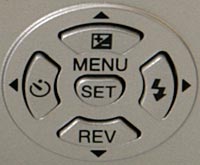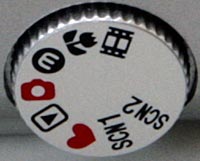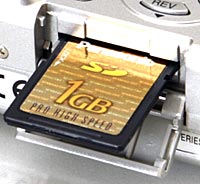Panasonic Lumix DMC-LS2 Review
Review Date: March 27th 2006
Leave a Comment about this Review
|
Ease of Use
The Panasonic Lumix DMC-LS2 is larger than you might think from looking at the glossy product shots, just about fitting into the palm of my hand. At 11cms wide and 3cms deep, the DMC-LS2 is more at home in a small camera bag than in your trouser or shirt pocket. As with most of the Panasonic LUMIX range of cameras, the LS2 looks more expensive than it actually is, with a smart silver plastic body. It's only when you pick it up that the camera betrays its budget price-tag. The DMC-LS2 is fairly well-made overall, but there are a few external controls that don't instill much confidence. The various covers for the battery compartment, SD card slot and DC In / USB ports feel a little insubstantial, and the On/Off Switch is not very positive. More annoyingly, the plastic tripod socket is positioned in the bottom-left corner of the camera, which doesn't make it very stable on a tripod. Still, none of these things actually stop the camera from working - they are more small annoyances that are a result of making the camera hit the low price point.
As this is purely a point and shoot camera with no manual controls, the Panasonic Lumix DMC-LS2 is not overly complex in terms of the number of external controls that it has. I counted 12 in total. The majority of the controls are clearly labeled and common to most cameras. There's a traditional dial on the top of the camera that lets you select the various shooting and scene modes, plus image playback. This dial is a typical feature of SLR cameras, and enables you to quickly change between the various modes. Interestingly there are two Scene modes on the dial, both of which offer exactly the same options, but which can be set independently of each other, allowing a little customization of the camera setup. Also found on the top of the camera are the on/off switch, zoom lever, shutter button and the optical image stabilisation button.
| Navigation Pad | Display/High Angle Button / Continuous Mode/Delete Button |
 |
 |
If you have never used a digital camera before, or you're upgrading from a more basic model, reading the easy-to-follow manual before you start is a good idea. Thankfully Panasonic have chosen to supply it in printed format, rather than as a PDF on a CD, so you can also carry it with you. The large 2 inch LCD screen is the only way of framing your shots, so if you have to have an optical viewfinder, look elsewhere now. There's a clever new mode called High Angle, which essentially brightens the LCD screen when the camera is held over your head so that it is perfectly viewable, which is great for shooting over the heads of a crowd. The various icons used to represent the camera settings are clear and legible, although I was annoyed by the High Angle message along the bottom of the screen, which is displayed whenever you press the Display button.
The main menu system on the Panasonic Lumix DMC-LS2 is straight-forward to use and is accessed by pressing the Menu/Set button in the middle of the navigation pad. There are two main menus, Record and Setup. Quite a lot of the camera's main options, such as white balance, image quality, auto-focus mode and ISO speed, are accessed here, so the Record menu has 10 options spread over 3 screens. It would have been good to see the more commonly used options, such as ISO speed, available via the press of a button, rather than having to go into the menu system. Due to the large LCD screen and restricting the number of on-screen choices to five, the various options and icons are clear and legible.
| Mode Dial | Zoom Lever / Shutter Button / On/Off Switch / Image Stabilisation Button |
 |
 |
There is one innovative feature on the Panasonic Lumix DMC-LS2 that aims to make life easier for you. As with current Panasonic models, this camera has an anti-shake system, dubbed Mega O.I.S - turn it on and the Panasonic Lumix DMC-LS2 automatically compensates for camera shake, which is a slight blurring of the image that typically occurs at slow shutter speeds. There are two different modes, Mode 1 is on all the time including image composition, and Mode 2 is only on when you press the shutter button. In practice I found that it does make a noticeable difference, as shown in the examples on the Image Quality page. You don't notice that the camera is actually doing anything different when anti-shake is turned on, just that you can use slower shutter speeds than normal and still take sharp photos. However, what Panasonic gives you in the form of an effective anti-shake system, it takes away by only providing a limited ISO range of 80-400. This essentially means that you really need to leave the anti-shake system turned on all the time to compensate for the slow shutter speeds, especially as ISOs 200 and 400 exhibit high levels of noise (see the Image Quality page), which negates some of the advantages that the anti-shake system offers. Thankfully leaving the anti-shake system on didn't negatively affect the battery-life, with the camera managing over 200 shots using the supplied AA Oxyride batteries (non-rechargeable).
| Battery Compartment | Memory Card Slot |
 |
 |
The start-up time from turning the Panasonic Lumix DMC-LS2 on to being ready to take a photo is average at around 2 seconds. Zooming from the widest focal length to the longest takes a pedestrian 3 seconds. Focusing is quick in good light and the camera achieves focus most of the time indoors or in low-light situations, although there is no focus-assist lamp. Note that the camera does struggle to lock onto the subject sometimes at the tele-photo end of the lens. The camera is very quick to find focus if you use the new 1-point high-speed AF option. The visibility and refresh rate of the 2 inch LCD screen are perfectly acceptable. It takes about 1 second to store an image, allowing you to keep shooting as they are being recorded onto the memory card - there is no LCD blackout between each image. The Panasonic Lumix DMC-LS2 has an average Continuous mode which enables you to take 3 frames per second at the highest JPEG image quality, up to a maximum of 5 images (Standard mode) or 3 images (Fine mode). Overall the Panasonic Lumix DMC-LS2 is average in terms of operational speed.
Once you have captured a photo, the Panasonic Lumix DMC-LS2 has a good range of options when it comes to playing, reviewing and managing your images. You can instantly scroll through the images that you have taken, view thumbnails, zoom in and out up to 16x magnification, view slideshows, delete, protect, trim, resize and rotate an image. You can also select favourite images and set the print order. The Display button toggles detailed settings information about each picture on and off, such as the ISO rating and aperture / shutter speed, and there is a small histogram available during both shooting and playback. When taking a photo, pressing the Info button toggles between the detailed information, the histogram and gridlines to aid composition.
In summary the Panasonic Lumix DMC-LS2 is a simple-to-use, fairly responsive and compact camera with an image stabilized Leica lens.
|
![]() PhotographyBLOG
is a member of the DIWA
organisation. Our test results for the Panasonic Lumix DMC-LS2
have been submitted to DIWA
for comparison with test results for different samples of
the same camera model supplied by other DIWA
member sites.
PhotographyBLOG
is a member of the DIWA
organisation. Our test results for the Panasonic Lumix DMC-LS2
have been submitted to DIWA
for comparison with test results for different samples of
the same camera model supplied by other DIWA
member sites.
